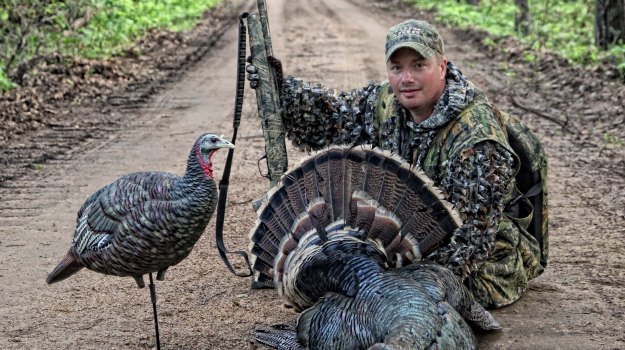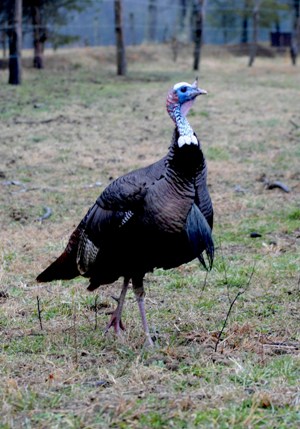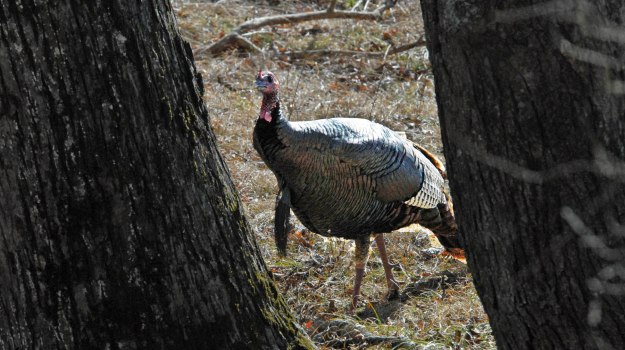Mossy Oak Pro Matt Morrett Teaches You How, When and Where To Take Public Land High Pressured Turkeys

Editor’s Note: Mossy Oak Pro Matt Morrett works for Zink Calls and Avian X Decoys. Matt won the Junior and Senior Grand National Turkey Calling contests, and the World Friction Turkey Calling Championships five times. He was only 16-years old when he won his first World Turkey Calling Championship.
My dad was a big-time turkey hunter in Pennsylvania, when I was growing up. During my younger years, turkey hunting was all the talk where I lived. Because I was born in Pennsylvania, I always knew about deer hunting. But my dad got bit by the turkey bug. It streamed though his veins, and he put that same love of turkey hunting into me and my blood. I can’t remember a time I haven’t gone turkey hunting with my dad.
We had a big outdoor show in Harrisburg, Pennsylvania, every year that was called the Eastern Sportsman Outdoors Show. I saw and heard some of the legends of turkey hunting there like Dick Kirby from Orchard Park, New York, Paul Butski, another Mossy Oak pro and a legend in turkey calling, Ernie Calandrelli, Ben Rodgers Lee from Coffeeville, Alabama, and Harold Knight and David Hale from Kentucky. These men were my idols. When I was a youngster, I didn’t really care much for football players or baseball players. But the men who could talk to turkeys and get those wily birds to come within shotgun range were people I was pretty sure could walk on water.
 The population of turkeys in central Pennsylvania where I grew up was not nearly as large as it is today. But through the efforts of the Conservation Department and the National Wild Turkey Federation (NWTF), we now have a large population of gobblers in my home state. When I was growing up, anyone who harvested a wild turkey had to work hard to get one of those gobbling bronze barons. Because everybody in the county where I lived was trying to take any turkey that could be heard gobbling, I learned at a young age that if I wanted to take a turkey gobbler, I had to go into the woods deeper and farther than most other hunters would hunt and find a gobbling bird that no one else had heard. I also learned that the better I could call to turkeys, the better my odds were for taking a turkey.
The population of turkeys in central Pennsylvania where I grew up was not nearly as large as it is today. But through the efforts of the Conservation Department and the National Wild Turkey Federation (NWTF), we now have a large population of gobblers in my home state. When I was growing up, anyone who harvested a wild turkey had to work hard to get one of those gobbling bronze barons. Because everybody in the county where I lived was trying to take any turkey that could be heard gobbling, I learned at a young age that if I wanted to take a turkey gobbler, I had to go into the woods deeper and farther than most other hunters would hunt and find a gobbling bird that no one else had heard. I also learned that the better I could call to turkeys, the better my odds were for taking a turkey.
But I learned at an early age to never give-up on turkeys. Pennsylvania homes a number of turkeys, a lot of public land and good road systems throughout that public land. So, I decided the best place to find a turkey that I could call in and take was a turkey that couldn’t be heard gobbling from the road. Most public-land hunters drive down the road, stop and listen for a turkey to gobble. If a turkey gobbles, the hunter will park his truck and make a beeline toward the turkey. So, I assumed that the turkeys that could be heard from any road on public land were the turkeys that would receive the most hunting pressure. The turkeys that couldn’t be heard from the road would get the least amount of hunting pressure. So, I chose to hunt the turkeys that couldn’t be hunted from the road. Because we have so many hills in Pennsylvania, I might only have to hunt 200-yards away from the road. However, in some areas, I might have to hunt two-miles away from public access.
Something else I learned from hunting public lands was that most hunters would leave the woods by 8:00 or 9:00 am. Perhaps they’d read books and magazine articles about taking turkeys off the roost. But I learned, if I didn’t get to the woods until 9:00 or 10:00 am, I’d have a better chance of bagging a gobbler than the early hunters would.
Another misconception is, “I want to hunt the first 2 weeks of the season, because that’s when my chances are best for taking a gobbler.” But I don’t believe that’s a fair assessment of public-land hunting. I’ve learned that I can take more turkeys later in the season than I can at the beginning of the season when every one else is pressuring the gobblers.
Tomorrow: Mossy Oak’s Matt Morrett on How to Find Late Season Public Land Gobblers



























